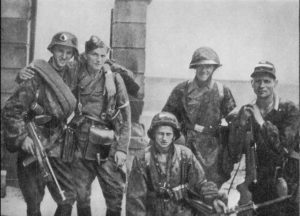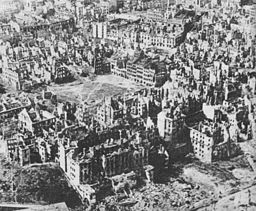
At 5 p.m. August 1, 1944 the Polish Home Army launched an offensive against occupying German troops. Some estimate a million people still remained in Warsaw. Civilians comprised the majority of fighters, including women, and children who served as couriers. Every Pole was an equal target to the Germans. Within a week, Germans conducted mass executions of some 65,000 civilians from recaptured parts of the city. I’ve met a woman who was fourteen years old during the Uprising. She served as a secret mail courier, and still bears the deep scar left by the bullet lodged in her leg by a German sharpshooter.

After two months and a day (it ended on October 1, Warsaw was surrendered on October 2) the Uprising ended in a total loss. German casualties neared 16,000; 9,000 wounded, and 2,000 captured by the insurgents. But the cost to Warsaw was far greater. It’s estimated 150,000 to 200,000 Poles lost their lives in the fight. Some 16,000 Polish Home Army lost their lives, approximately 55,000 civilians ended up in concentration camps as ‘dangerous elements’ and 150,000 were sent back to Germany as forced labor. After banishing all remaining Poles from the city, the Germans freely looted anything left of value before flattening the city. Some estimate nearly 33,000 train cars of furniture, valuables, and factory equipment were shipped back to Germany.
The Russians proved an equal enemy to the Poles. They made no move towards the capital city to aid the Poles, by de facto allowing Germany to destroy the city. They finally moved into Warsaw and claimed (or in their terms “liberated”) the deserted, demolished city on January 17, 1945. After the war, the Russians sought out any surviving Polish army or insurgents and executed them in a pre-emptive move to wipe out potential opposition to communist rule.
The Warsaw Uprising Museum opened in 2004. Today it houses an impressive collection of stories, artifacts and educational materials on the Warsaw Uprising. I visited it in 2013 and in my opinion, it rivals any Smithsonian museum in Washington D.C. I thoroughly recommend Po wstanie Warszawski, a Polish language film with English subtitles, created entirely from recovered film footage made during the Uprising. It’s only for sale in Poland right now; a good friend loaned me his personal copy to watch.
wstanie Warszawski, a Polish language film with English subtitles, created entirely from recovered film footage made during the Uprising. It’s only for sale in Poland right now; a good friend loaned me his personal copy to watch.
Previous post on Warsaw Ghetto Uprising and the Warsaw Uprising
Note to my regular readers: The frequency of blogs has slowed temporarily, as I’ve finished the final edits on my manuscript. Thank you for patience as this project moves forward.

2 Comments. Leave new
Thank you for writing about this. It was such a terrible time. People had to be brave and smart to survive. I posted this on my Paper Children website.
Thanks for sharing Marcia. I’m always amazed at just how much Poland and her people have suffered. It’s a history that needs to be told.